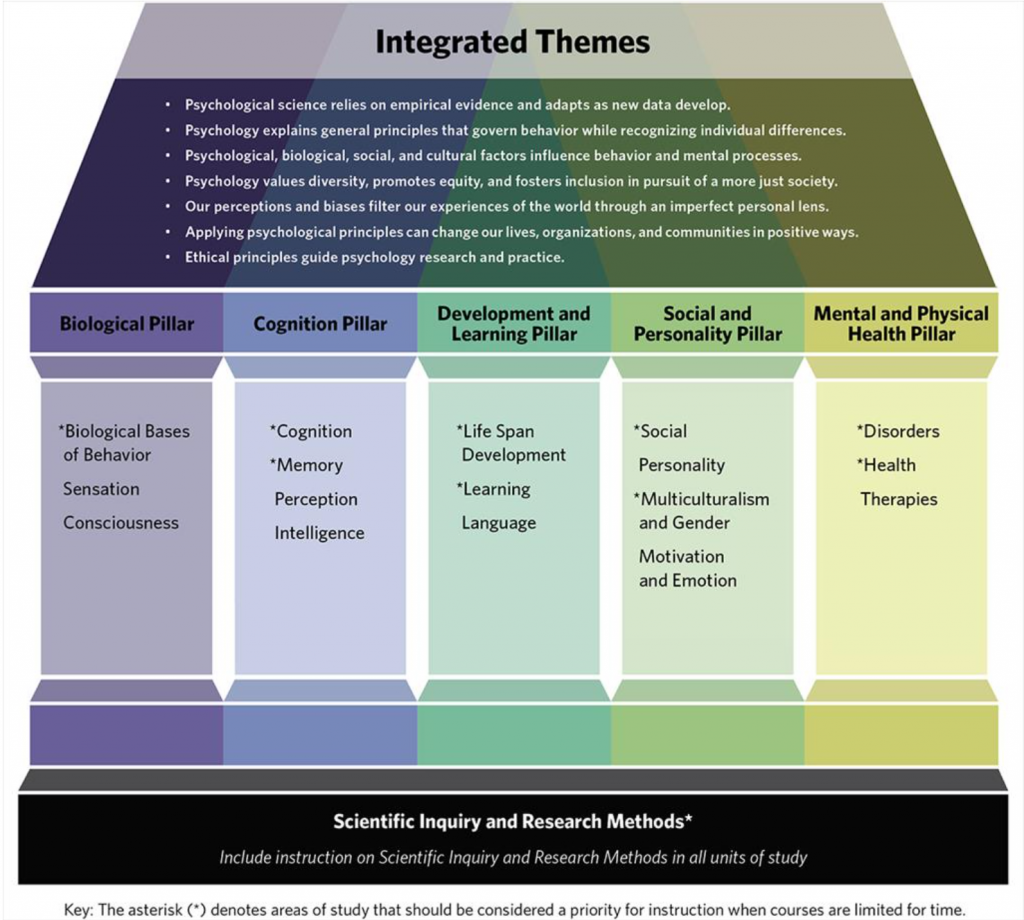Organization
Karenna Malavanti
Psychological Science uses OpenStax 2e Psychology textbook as a foundation and also contains other material curated by NOBA (Introduction to Psychology: The Full NOBA Collection) and Lumen Learning (Introduction to Psychology). This text was created by Karenna Malavanti at Baylor University with the help of Christina Chan-Park (Baylor University), Bridgette Martin Hard (Duke University), and Alison Melley (George Mason University).
The textbook is organized around the recently recommended pillar model from the Introductory Psychology Initiative (IPI) at the American Psychological Association (APA).
Psychological science is a field that many students easily tie to their experiences in the real world. Understanding and interpreting research is at the foundation of psychological science, so we will spend time at the beginning of the course learning about how psychologists conduct research and interpret scientific reasoning. From there, we will cover each of the five psychological pillars (biological, cognitive, developmental, social/personality, mental & physical health) to gain a knowledge base of each domain and appreciate how all pillars are integrated within the human condition (see “Strengthening Introductory Psychology: A New Model for Teaching the Introductory Course”).

This Pillar Model encompasses five major subdisciplines of psychology: biological psychology, cognitive psychology, developmental and learning psychology, social and personality psychology, and mental and physical health. Each pillar relies on the same foundations of research methods and scientific principles to draw conclusions about human behavior. Within each pillar we will also address the seven integrative themes recommended by the APA IPI (see “APA Introductory Psychology Initiative Student Learning Outcomes for Introductory Psychology“):
-
- Psychological science relies on empirical evidence and adapts as new data develop.
- Psychology explains general principles that govern behavior while recognizing individual differences.
- Psychological, biological, social and cultural factors influence behavior and mental processes.
- Psychology values diversity, promotes equity, and fosters inclusion in pursuit of a more just society.
- Our perceptions and biases filter experiences of the world through an imperfect personal lens.
- Applying psychological principles can change our lives, organizations, and communities in positive ways.
- Ethical principles guide psychology research and practice.
Thus, we will answer questions such as: How does the field of psychology adapt to new findings? Does knowing about a specific topic mean every person will act in the same way? How does this topic relate to everyday life, and what affects how that topic will affect me? How do individuals in different cultures or societies differ on these concepts? Does knowing about psychology topics make me a more considerate and understanding person? How do we apply these topics to to better our communities? And, how do we ethically engage in psychology research and practice?
At the beginning of each section of the book, we will briefly describe how these themes will show up in that specific pillar.
Throughout the book, you will see a number of boxes that contain material that help reinforce your learning. A description of the different boxes is given below.
Learning Objectives
Student learning objectives are in green boxes like this.
Try It
Vocabulary word flashcards and non-graded mini-quizzes are in the grey boxes.
Watch It or Link to Learning
Video examples and links to outside learning will be in purple boxes like this
Dig Deeper
Helpful hints, connect the concepts, case studies, and work it out will be in teal colored boxes and will encourage you to dig deeper.
Think It Over
Key takeaways, food for thought, and reflections from each section will be in orange boxes
References, Licenses, and Attributions
References, Licenses, and Attributions are in white boxes.
